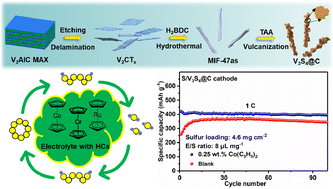Synergistic design of core–shell V3S4@C hosts and homogeneous catalysts promoting polysulfide chemisorption and conversion for Li–S batteries†
Abstract
Li–S batteries (LSBs), owing to their superior energy density, cost-efficiency, and environment-friendliness, are established as one of the most potential next-generation electrochemical energy storage systems. However, the shuttle effect of lithium polysulfides (LPSs) and the poor conductivity of active substances are the main challenges to their practical applications. Herein, we propose a synergistic strategy involving heterogeneous and homogeneous catalysts. First, MIL-47 as-derived core–shell carbon nanorods decorated with a V3S4 nanosheet shell (V3S4@C) were smartly constructed and applied as the host material for sulfur cathodes. The resulting V3S4@C not only enhanced the electronic conductivity of the integrated cathode but promoted LPSs chemisorption and conversion as heterogeneous catalysts. The optimized Co(C5H5)2 was further introduced into the electrolyte as a homogeneous catalyst, improving the conversion efficiency of LPSs and electrolyte wettability. Benefiting from the synergistic contributions of the V3S4@C host and the homogeneous catalyst Co(C5H5)2, the assembled LSBs with S/V3S4@C as the cathode exhibited outstanding long-life cycling performance and high-rate behavior, particularly in cases with high sulfur loading and low electrolyte dosage. More significantly, our work promises a feasible pathway for commercial applications of advanced LSBs.

- This article is part of the themed collection: 2023 Journal of Materials Chemistry A HOT Papers


 Please wait while we load your content...
Please wait while we load your content...